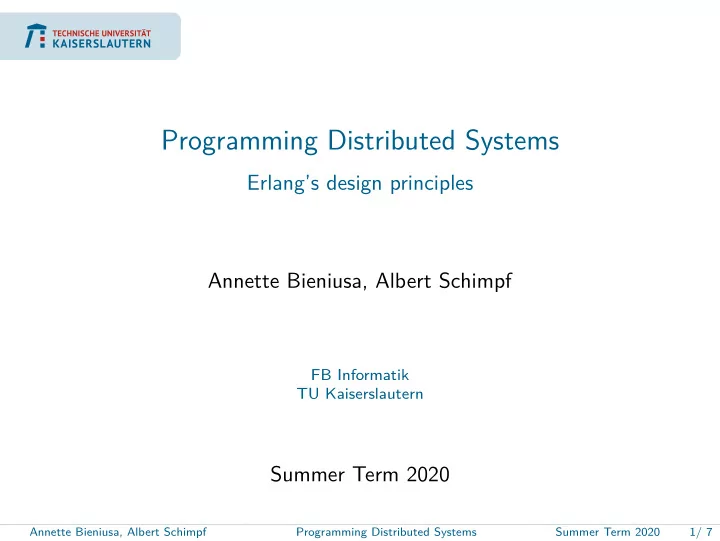

Programming Distributed Systems Erlang’s design principles Annette Bieniusa, Albert Schimpf FB Informatik TU Kaiserslautern Summer Term 2020 Annette Bieniusa, Albert Schimpf Programming Distributed Systems Summer Term 2020 1/ 7
Problem domain Need to handle very large number of concurrrent activities Soft real-time : Tasks need to be handled within a specific time Distributed over several computers Continuous operations for many years Maintenance without stoppping the system Fault tolerance Annette Bieniusa, Albert Schimpf Programming Distributed Systems Summer Term 2020 2/ 7
Design goals[1] Organize system as set of communicating processes Processes are identifiable by unique, unforgeable Pid No sharing of data between processes Supports both multi-processor and distributed systems Caveat: Might be inefficient if strong data dependencies between processes Message passing is assumed to be asynchronous, but ordered and atomic Must be able to identify failure in a process (and its potential reason) Annette Bieniusa, Albert Schimpf Programming Distributed Systems Summer Term 2020 3/ 7
Erlang View of the World[1] 1 Everything is a process. 2 Processes are strongly isolated. 3 Process creation and destruction is a lightweight operation. 4 Message passing is the only way for processes to interact. 5 Processes have unique names. 6 If you know the name of a process you can send it a message. 7 Processes share no resources. 8 Error handling is non-local. 9 Processes do what they are supposed to do or fail. Annette Bieniusa, Albert Schimpf Programming Distributed Systems Summer Term 2020 4/ 7
Erlang’s Concurrent programming in a Nutshell Pid = spawn(F) Pid ! Msg receive MsgPattern1 -> Expr1; MsgPattern2 -> Expr2; MsgPattern3 -> Expr3; ... % optional timeout end Annette Bieniusa, Albert Schimpf Programming Distributed Systems Summer Term 2020 5/ 7
The Actor model[2] Mathematical model of concurrent computation Erlang’s philosophy is very close to the actor model Differences: FIFO ordering of message sending, processes are sequential, . . . Actor Computational entity that can send finite number of messages to other actors it knows create finite number of new actors designate what to do with the next message Annette Bieniusa, Albert Schimpf Programming Distributed Systems Summer Term 2020 6/ 7
Further reading I [1] Joe Armstrong. ”Making reliable distributed systems in the presence of software errors“. Diss. Royal Institute of Technology, Stockholm, Sweden, 2003. url : http://erlang.org/download/armstrong thesis 2003.pdf. [2] Carl Hewitt, Peter Boehler Bishop und Richard Steiger. ”A Universal Modular ACTOR Formalism for Artificial Intelligence“. In: Proceedings of the 3rd International Joint Conference on Artificial Intelligence. Standford, CA, USA, August 20-23, 1973 . Hrsg. von Nils J. Nilsson. William Kaufmann, 1973, S. 235–245. url : http://ijcai.org/Proceedings/73/Papers/027B.pdf. Annette Bieniusa, Albert Schimpf Programming Distributed Systems Summer Term 2020 7/ 7
Recommend
More recommend